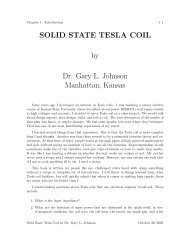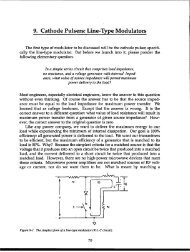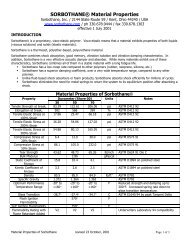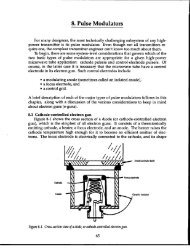3.6M north10.pdf - Dean-O's Toy Box
3.6M north10.pdf - Dean-O's Toy Box
3.6M north10.pdf - Dean-O's Toy Box
You also want an ePaper? Increase the reach of your titles
YUMPU automatically turns print PDFs into web optimized ePapers that Google loves.
Cathode Pulsers: Hard-Tube Modulators (10) 167<br />
please their users because net grid current isalways higher forthem than conventional<br />
grids. Higher current means that grid drive circuits and screen-grid<br />
power supplies have to be rated for more output current. Nevertheless, with<br />
pyrolytic-graphite grids and screens there is less likelihood of tube-to-tube variations,<br />
or variations within a single tube over its life span.<br />
In oxide-cathode tubes, pulse duration is limited by the cathode. In thoriatedtungsten<br />
tubes, pulse duration is usually limited by intrapulse grid heating, which,<br />
ignoring heat lost by radiation, is adiabatic, meaning that no heat is dissipated<br />
during the pulse itself. Therefore, the temperature rise is proportional to the<br />
pulse energy, which is the product of peak power and pulse duration, and inversely<br />
proportional to the product of grid-wire mass and specific heat. If power<br />
is expressed in watts, pulse length in seconds, and mass in grams, the proportionality<br />
constant for temperature rise in degrees Celsius is 0.24. With grid temperature<br />
at 1400°C, however, radiation losses are fortunately not insignificant.<br />
The last electrode of a power grid tube is, of course, the anode, which is<br />
where we would like the majority of our cathode-emitted electrons to end up. A<br />
tube designer wants the electrons to arrive at the anode with a kinetic energy that<br />
is as small as possible relative to the anode area and the spacing between anode<br />
and outermost grid. This kinetic energy and the rate of electron arrival-which<br />
is, of course, the anode current-determine the anode dissipation. Only so much<br />
can be done to minimize it, and a conduction-anode drop that is 10?4oof the<br />
anode hold-off voltage is considered a good design, resulting in 90% anode efficiency<br />
as a modulator switch. The bulk of anode design, other than geometric<br />
requirements, falls in the category of heat transfer, which will be touched upon in<br />
a later section.<br />
Needless to say, grid and/or screen current does no one any good, and tube<br />
designers have exercised a great deal of their creativity in minimizing it. Now<br />
we will look at a few actual tube designs to see what has been accomplished in<br />
this regard. (Remember, of course, that almost nothing new has been done in this<br />
field for almost 30 years.)<br />
10.4.1 The 7560 triode switch tube<br />
Figure 10-12 shows the plate (anode) current characteristics for the 7560 triode<br />
modulator switch tube, which once was simultaneously manufactured by three<br />
of the largest and most competent power-vacuum-tube sources in the world.<br />
Today it may not be made by anyone, because two of the three have ceased<br />
operations and the third may no longer be interested. Nevertheless, there is still<br />
a host of operating sockets for the tube type, and shops that can rebuild it still<br />
flourish. The figure also shows the characteristics of another power triode, the<br />
8547, which is not primarily a modulator switch tube because its nominal anodevoltage<br />
rating is 17 kV. Both tubes have water-cooled anodes capable of dissipating<br />
175 kW of power. The 7560 differs from the 8547 only in the increased<br />
spacing between its anode and grid, which is required to achieve its 50-kV anode-voltage<br />
hold-off rating. Because the anode is farther away from the grid in<br />
the 7560, a designer would expect that greater grid-anode voltage drop would be<br />
required for a given amount of anode current given its virtual-cathode effect.<br />
Indeed, the effect is clearly illustrated in Fig. 10-12a by the slope of the “diode







